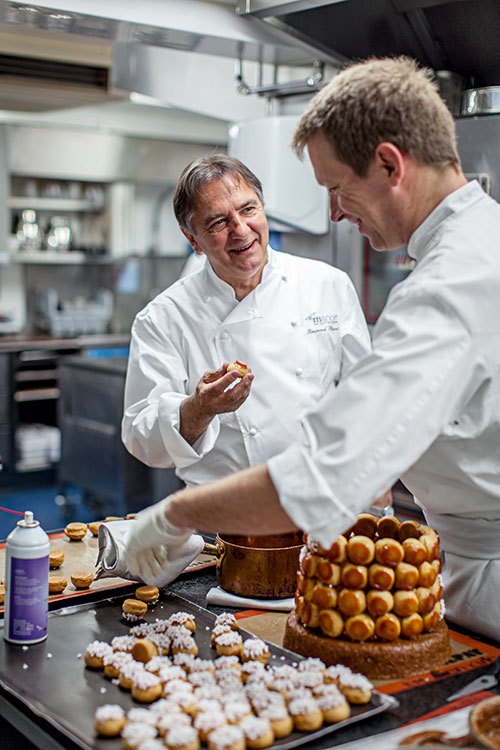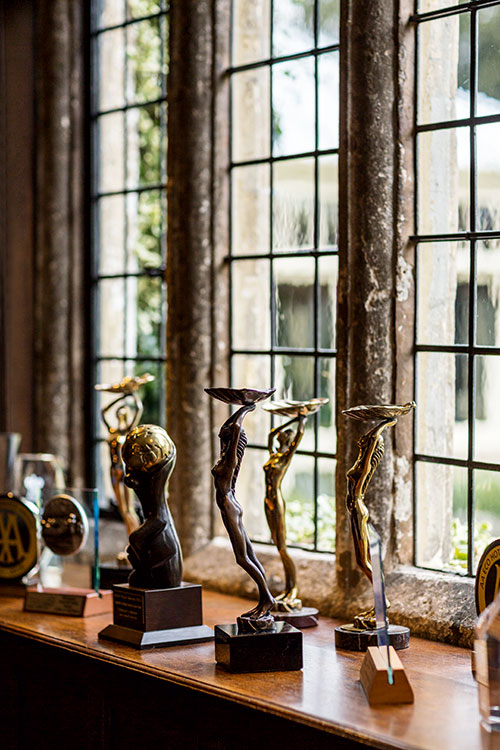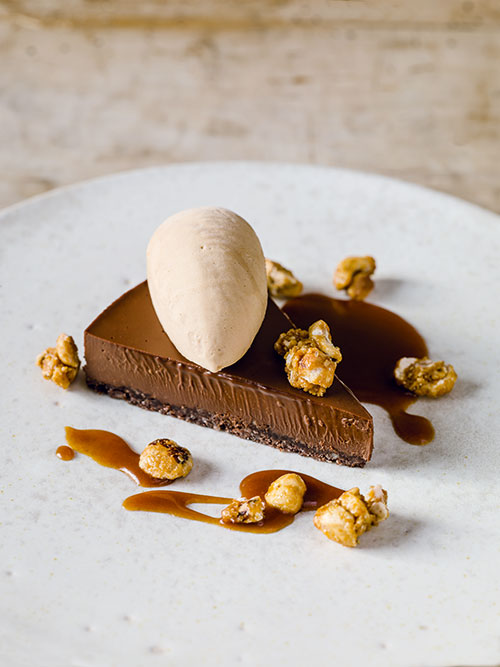Le Manoir aux Quat'Saisons: Raymond Blanc's fairy tale made real
This month, Raymond Blanc publishes a cookery book that gives readers a personal tour of his beloved Le Manoir. With recipes highlighting the four seasons of the year, showcasing his splendid gardens, the acclaimed chef also shares the stories behind his distinctive and luxurious bedrooms. Janet Harmer dives into the mighty tome
By Raymond Blanc
Photography Chris Terry
Illustrations MH Jeeves
Bloomsbury, £50
The opening of this weighty book - nearly 500 pages long - reads like a fairy tale. An odd way, perhaps, to kick-start a cookery book that doubles as a history of what has undoubtedly been one of the UK's most inspirational restaurants and hotels in recent years. However, if you know Raymond Blanc and understand what he has achieved, then the story of Le Manoir aux Quat'Saisons as a fairy tale makes perfect sense.
Certainly, the fact that Blanc went from running the unassuming Oxford restaurant Le Manoir, measuring 90 sq m, to owning a grand 15th-century manor house set within 27 acres of grounds, when his ambitions had been for nothing more than a restaurant in a country cottage, is something that dreams are made of.
Raymond Blanc and Benoit Blin, chef patissier at Le Manoir
From the outset though, it is clear that the dream only became a reality because of Blanc's self-belief and determination, which led him to rise from a self-taught stand-in cook to winning and retaining two Michelin stars for more than 30 years, during which time he has developed Le Manoir into a sprawling 32-bedroom hotel with a cookery school and one of the UK's most impressive kitchen gardens.
While there have been many highlights along the way, there have also been a number of dark moments, including the break-up of Blanc's marriage to Jenny, the mother of his two sons; the expansion of the business just as the country plunged into recession; and the failure of his health, culminating in a stroke brought on by stress.
In the introduction, Blanc talks about the highs and lows with searing honesty, including the decision he took to offload his financial stake in Le Manoir, initially to Richard Branson and his Virgin empire, and later to Orient-Express (now Belmond). He goes on to explore how the four seasons affect both the garden and kitchen at Le Manoir, as well as inform the design of the property, which has been transformed over the years from outdated country house decor to what Blanc describes as "triumphant modernity", created in conjunction with interior designer Emily Todhunter. A total of 120 recipes are sprinkled throughout.
This is a triumph of a book, a real collector's piece, which celebrates the blood, sweat and tears - along with a generous dollop of love - that have gone into creating Le Manoir.
The business is probably the clearest example I know of one that has evolved without compromising on expenditure - after all, Blanc believes that compromise would equate to "selling my soul". It is not something that many operators can honestly claim they have been able to achieve, but luckily for us, Le Manoir has done so, as this book so beautifully illustrates. A real-life fairy tale.
Merlu Á la Grenobloise, purée de pommes de terre (hake, Grenobloise sauce, potato purée)
Although not as sumptuous as cod, line-caught hake is still a wonderful fish with a great texture and big flavour. This simple and delicious dish is cooked in homes all over France. Originating from Grenoble, the piquant sauce is flavoured with beurre noisette, capers, parsley and lemon. If you like, you could replace the hake with pollock or Atlantic cod, although I feel that cod stocks still need time to replenish themselves further. The best potato for the purée is a French variety, Agata, which is a huge, yellow-fleshed tuber, but Belle de Fontenay is an excellent all-rounder and a good alternative.
Serves 4
- 4 hake fillets (180g each and 3cm thick), skin on
- 40g unsalted butter
- Sea salt and finely, freshly ground white pepper
For the potato purée
- 1kg Agata, Belle de Fontenay or Estima potatoes, peeled
- 170ml-200ml whole milk, hot
- 70g unsalted butter, melted
For the sauce
- 50ml water or brown chicken stock
- Juice of ½ lemon
- 2tbs capers, washed and drained
- 1 shallot, peeled and finely chopped
- 10g flat-leaf parsley, finely shredded
To serve
- 15g croÁ»tons (oven-toasted 1cm white bread cubes)
Preheat the oven to 180°C/Gas 4. For the potato purée, halve or quarter the potatoes to an even size, place in a large saucepan and cover with cold water. Bring to the boil, then lower the heat and simmer gently for 25 minutes. The potatoes should be cooked right through and soft enough to break when touched.
Drain in a colander and leave to steam for 2-3 minutes. Pass through a fine mouli back into the saucepan. Using a wooden spoon, gradually mix in the hot milk, then stir in the melted butter and two pinches each of salt and pepper. Taste and adjust the seasoning.
If the purée is too firm, add a little more milk. The perfect potato purée is fluffy, forms firm peaks and melts in your mouth. Keep warm in a bain-marie.
Pat the hake fillets dry, score the skin and season the flesh side with four pinches of salt and two pinches of pepper.
Melt the butter in a large ovenproof frying pan over a medium heat and bring to the foaming stage. Add the hake fillets skin side down and cook for 5-6 minutes to achieve a crisp and golden skin. Using a fish slice, carefully turn the fillets over and cook for one minute. Transfer the pan to the oven and cook for a further four minutes. Gently lift the hake fillets onto a warmed plate.
To make the sauce, put the pan back over a high heat and add the water or chicken stock. Add the lemon juice, capers, shallot and shredded parsley and bring back to a simmer. Taste and correct the seasoning if necessary.
Spoon some potato purée onto each warmed plate and rest a hake fillet on top. Spoon the sauce over and around the fish and scatter over the croÁ»tons. Serve at once.
Variations
You can flavour the potato purée - with puréed blanched garlic, olive oil, chopped herbs of your choice, horseradish, mustard or nutmeg.
Crémeux au chocolat, caramel citronvert, crème glacée Á la noisette (chocolate crémeux, lime butterscotch, hazelnut ice-cream)
This beautiful dessert is simple to prepare. A chocolate crémeux sits atop a crumble base, which gives a fantastic texture. It is served with lime butterscotch sauce, a quenelle of hazelnut ice-cream and a few caramelised hazelnuts.
The crémeux should be made at least six hours ahead. Indeed, the dessert can be completed a day in advance.
Serves 8
For the crumble base
- 35g cold unsalted butter
- 35g demerara sugar
- A small pinch of salt
- 30g plain flour
- 1½tsp cocoa powder
For the chocolate crémeux
- 155g good quality dark chocolate (70% cocoa solids), in pieces
- 1 organic/free-range medium egg
- 90ml whipping cream
- 150ml whole milk
For the caramel hazelnuts and ice-cream
- 400g whole hazelnuts (skin on)
- 40ml water
- 180g caster sugar
- A pinch of sea salt
- 400ml milk
- 100ml whipping cream
- 6 organic/free-range medium egg yolks (120g)
For the lime butterscotch sauce
- 180ml whipping cream
- 40ml water
- 180g caster sugar
- 75g freshly squeezed lime juice, heated
- 5g finely grated lime zest
- 10g fresh ginger, peeled and finely grated
- Sea salt and freshly ground black pepper
For the crumble base, preheat the oven to 170°C/Gas 3. Stand an 18cm tart ring on a baking tray lined with greaseproof paper.
Pulse all the ingredients together in a food processor for a few seconds, to a crumble texture. Sprinkle the crumble evenly into the tart ring and press down lightly. Bake for 10-12 minutes. Remove from the oven and set aside to cool.
For the crémeux, melt the chocolate in a bain-marie. Lightly beat the egg in a medium bowl. Bring the cream and milk to the boil, then pour onto the egg, whisking all the time.
Slowly whisk this mixture into the melted chocolate. Leave to settle; skim off any bubbles. Pour the chocolate mixture over the crumble base in the tart ring.
Let cool for 30 minutes, then refrigerate for 6-24 hours.
For the caramel hazelnuts, heat the oven to 180°C/Gas 4. Scatter the nuts on a baking tray and roast for 10 minutes. Leave to cool, then wrap the nuts tightly in a cloth and rub to remove the skins. Pick out the nuts and set aside.
Put the water in a medium pan, add 100g of the sugar and leave for a few minutes. Heat, stirring, to melt the sugar and cook to a dark caramel. Carefully add the hazelnuts and salt, turn the nuts with a spoon to coat in the caramel, then tip onto a greased tray and leave to cool for one hour.
When the caramel hazelnuts are set firm, break them up. Put 250g into a food processor and pulse to a coarse texture; do not grind to a powder. Set aside. Reserve the remaining whole caramel hazelnuts for decoration.
For the ice-cream, freeze the bowl of your ice-cream machine. Warm the milk and cream in a medium saucepan over a medium heat. Meanwhile, in a large bowl, cream the egg yolks and remaining 80g sugar together until the mixture is pale.
Whisk in the hot creamy milk, then pour back into the pan and stir over a medium heat until the custard is thick enough to coat the back of a wooden spoon. Stir in the 250g ground hazelnuts. Pour into a bowl and set over ice to cool quickly, then churn in the ice-cream machine for 25 minutes, or until thick.
For the sauce, bring the cream to the boil in a small pan. Put the water into another, large saucepan, add the sugar and leave for a few minutes. Now heat, stirring, to melt the sugar evenly, then let it colour to an amber caramel.
Carefully pour in the hot lime juice, lime zest and grated ginger, followed by the hot cream; it will bubble fiercely. Stir well and bring back to the boil. Cook for 3-4 minutes until thick enough to coat the back of a spoon. Add a pinch each of salt and pepper. Let cool, then refrigerate.
To serve, once the chocolate crémeux has set, warm the ring with a cook's blowtorch and lift it from the tart. With a warm knife, cut the tart into slices. Top with a quenelle of hazelnut ice-cream and serve with the lime butterscotch sauce and a scattering of caramelised hazelnuts.
Continue reading
You need to be a premium member to view this. Subscribe from just 99p per week.
Already subscribed? Log In














